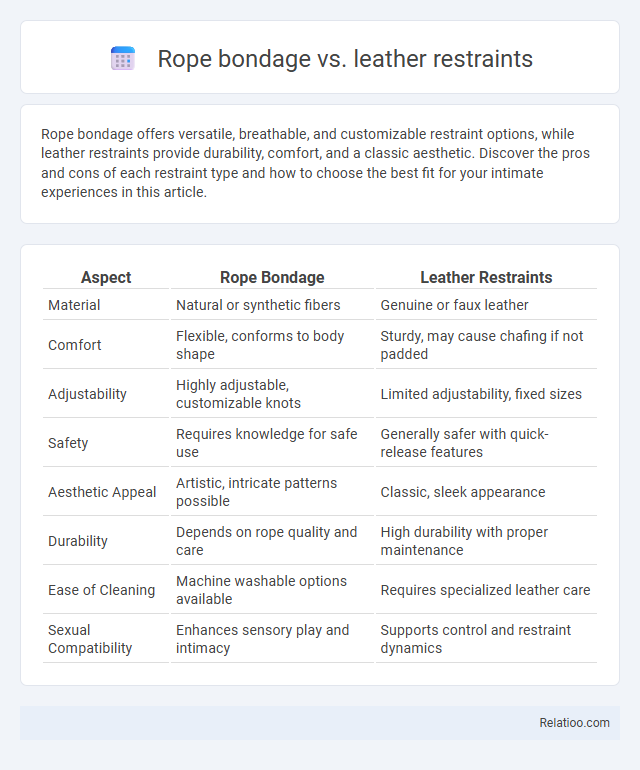Rope bondage offers versatile, breathable, and customizable restraint options, while leather restraints provide durability, comfort, and a classic aesthetic. Discover the pros and cons of each restraint type and how to choose the best fit for your intimate experiences in this article.
Table of Comparison
| Aspect | Rope Bondage | Leather Restraints |
|---|---|---|
| Material | Natural or synthetic fibers | Genuine or faux leather |
| Comfort | Flexible, conforms to body shape | Sturdy, may cause chafing if not padded |
| Adjustability | Highly adjustable, customizable knots | Limited adjustability, fixed sizes |
| Safety | Requires knowledge for safe use | Generally safer with quick-release features |
| Aesthetic Appeal | Artistic, intricate patterns possible | Classic, sleek appearance |
| Durability | Depends on rope quality and care | High durability with proper maintenance |
| Ease of Cleaning | Machine washable options available | Requires specialized leather care |
| Sexual Compatibility | Enhances sensory play and intimacy | Supports control and restraint dynamics |
Introduction: Understanding Rope Bondage and Leather Restraints
Rope bondage involves using soft, flexible ropes to create intricate patterns and secure restraints, emphasizing both aesthetic appeal and functional control. Leather restraints offer durable, adjustable options that provide firm hold and enhanced comfort through padded materials and secure buckles. Understanding the distinctions between rope bondage and leather restraints is essential for selecting safe, comfortable, and consensual fetish play tools tailored to individual preferences.
Historical Origins and Cultural Background
Rope bondage traces its roots to ancient Japanese Shibari, emphasizing intricate knots and artistic restraint techniques developed centuries ago, while leather restraints emerged prominently in Western BDSM culture during the mid-20th century, symbolizing durability and dominance. Fetish culture, encompassing a broad spectrum of materials and practices, has historic ties to the early 1900s European avant-garde movements, evolving through underground communities into mainstream acceptance. Your understanding of these practices benefits from recognizing their distinct historical origins and cultural significance within the global BDSM and fetish milieu.
Material Composition and Sensations
Rope bondage utilizes natural fibers like jute or hemp, offering a textured and flexible sensation that molds closely to the skin, enhancing tactile intimacy. Leather restraints provide a smooth, sturdy, and durable material often infused with oils for a polished finish, delivering a firm yet comfortable pressure ideal for secure restraint. Your choice between these materials significantly impacts sensory experience and comfort, with rope offering warmth and breathability, while leather delivers sleekness and resilience in fetish play.
Safety Considerations and Risk Factors
Rope bondage requires careful attention to circulation and nerve compression, with safety scissors and clear communication essential to prevent injury. Leather restraints offer durability and ease of release but can cause bruising or skin irritation if applied too tightly or used for prolonged periods. Fetish gear varies widely in materials and design, so assessing allergenic potential, joint strain, and proper fit is crucial to minimize risks and maintain user safety during play.
Versatility and Customization Options
Rope bondage offers exceptional versatility with limitless tying patterns and adjustable tightness, allowing for highly personalized restraint experiences tailored to individual preferences. Leather restraints provide durable and customizable options through adjustable buckles, various widths, and added hardware like D-rings, enhancing both comfort and security. Fetish gear encompasses a broad range of materials and designs, enabling users to select specific aesthetics, textures, and functionalities that align with distinct desires and scenes.
Comfort and Wearability for Extended Use
Rope bondage offers flexibility and breathability, making it comfortable for extended wear when tied correctly with smooth, natural fibers. Leather restraints provide durability and a luxurious feel but may cause discomfort or skin irritation during long sessions without proper padding or breaks. Your choice should balance sensation preferences and wearability, ensuring safety and comfort for prolonged use.
Aesthetic Appeal and Visual Impact
Rope bondage offers an intricate, artisanal aesthetic characterized by its natural fibers and intricate patterns that create a visually striking contrast against the skin, emphasizing both vulnerability and beauty. Leather restraints provide a sleek, bold appearance with a polished finish that conveys strength and intensity while highlighting the wearer's form in a minimalistic yet powerful way. Your choice between rope and leather restraints can significantly affect the visual impact and overall fetish vibe, transforming the scene with either elaborate texture or streamlined dominance.
Ease of Use: Beginners vs Experienced Practitioners
Rope bondage offers adjustable tension and creative versatility, making it ideal for experienced practitioners who understand knot techniques and safety, while beginners may find it challenging without proper guidance. Leather restraints provide straightforward application and durability, favoring ease of use for beginners seeking quick setup and reliability. Fetish gear encompasses diverse materials and complexity levels, catering to both novices with simple designs and experienced users exploring advanced sensory experiences.
Maintenance and Durability
Rope bondage requires regular cleaning and conditioning to prevent fiber weakening and maintain flexibility, with natural fibers like jute needing more care than synthetic ropes. Leather restraints are highly durable but demand consistent maintenance, including cleaning, conditioning, and proper storage to avoid cracking and stiffness. Fetish gear materials vary widely; however, those made from rubber, silicone, or PVC typically require specialized cleaners and careful handling to preserve their texture and longevity.
Choosing the Right Restraint for You
Choosing the right restraint involves considering comfort, flexibility, and the desired intensity of sensation; rope bondage offers customizable tightness and artistic potential but requires knowledge for safe use, while leather restraints provide durability, ease of use, and a firm hold suited for beginners and experienced users alike. Fetish restraints encompass a broader category including materials like metal and silicone, catering to specific sensory preferences and aesthetic appeal, often enhancing the psychological aspect of restraint play. Prioritize personal safety, communication, and individual preference when selecting restraints to ensure an enjoyable and consensual experience.

Infographic: Rope Bondage vs Leather Restraints
 relatioo.com
relatioo.com